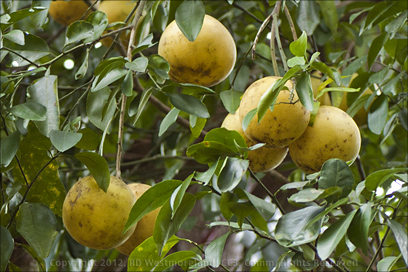This page is dedicated to my gardening efforts in PR. If you like running your hands through soil.. working on the cheap – Hola!
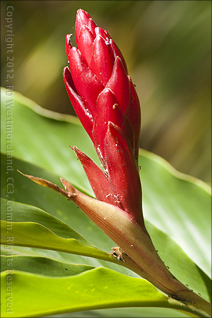 Be warned, I’m new to gardening so I’m starting from scratch. I have spent many, many hours online researching this stuff, but it’s no substitute for get’n out and get’n dirty.
Be warned, I’m new to gardening so I’m starting from scratch. I have spent many, many hours online researching this stuff, but it’s no substitute for get’n out and get’n dirty.
If gardening is your thing and you want to read more Posts on the subject, click on the ‘Gardening in Puerto Rico’ link in the Menu on the right.
Roberto’s Gardening Interests
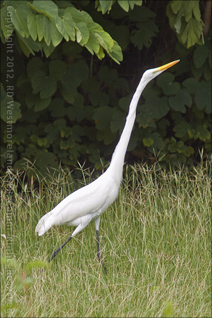 My primary interest is in fruit and nut bearing trees. Some flowering plants and exotic trees are also featured. If I know the botanical name, I’ll include it in the description.
My primary interest is in fruit and nut bearing trees. Some flowering plants and exotic trees are also featured. If I know the botanical name, I’ll include it in the description.
What follows is a list of plants and trees we have growing on the property. Many, many more are in the works.
Among them- 2 varieties of bananas, a hybrid grafted mango Tree, a hybrid grafted avocado tree, a Mexican lemon tree, several almond trees, 3 mystery nut trees, 2 guanabana trees, a Puerto Rican grapefruit tree, several coconut palms (but only one produces so far), an acerola tree and several small Caballeros hot pepper bushes (tiny, but deadly hot) also known as Chiltepin. There are also a couple of orange trees and coffee plants, but they area not doing so well.
I can say that bananas, mangos, papaya, coconut, almonds, guanabana, noni and any citrus will thrive here. The only thing needed is a little fertilizer twice a year, but it’s optional and some water during the Dry Season unless you live where it rains year round.. like the east shore or up in the mountains.
Here’s what we have growing now-
These are not the commercial Grapefruit most of us think of. They are chock full of seeds! These have thick, pale yellow skin with pale flesh. Not sweet at all, but very flavorful. Great for juice, once I add a bunch of sugar to the mix. Talk about tart! We got a little over 4 gallons of juice from about 4 dozen fruit this year. I filled 16oz. plastic Coke bottles and froze them for later. That does not count the dozen or so I pulled and made into juice from before our little harvest. The tree stands about 2o feet tall.
Bananas
I started with about 6 plants each of both Sweet Bananas (not sure of the variety) and Mofafo (Mafafo?) platanos for cooking. Mofafo are the ones most folks want for making Tostones. If allowed to ripen, they are often fried and served for breakfast. Even ripe, they are only slightly sweet to the taste.
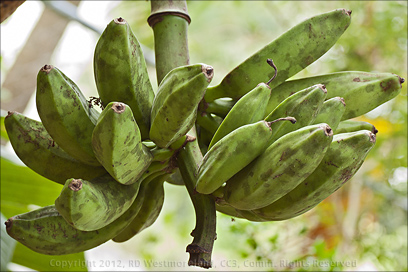 The traditional Banana most folks are familiar with can also be cooked green. When prepared that way, they more resemble a firm potato and are most delicious.
The traditional Banana most folks are familiar with can also be cooked green. When prepared that way, they more resemble a firm potato and are most delicious.
Banana plants will toss off new sprouts at the base of a mature plant after about a year to 18 months. This is how they propagate. My plants have averaged 5 to 7 babies per plant. I transplanted a bunch of them at the beginning and now, 2 years later, one of those has finally produced fruit. All of those transplants now have babies of their own. It still takes another 4 months before fruit is ready to harvest, though they can be eaten green at any time. 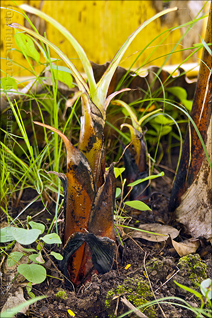 Today, I have about 2 dozen mature plants of both types with another dozen babies to relocate. My goal is to get to about 3 dozen mature plants of each type. Under our conditions, I would say it takes about 3 years to achieve full maturity.
Today, I have about 2 dozen mature plants of both types with another dozen babies to relocate. My goal is to get to about 3 dozen mature plants of each type. Under our conditions, I would say it takes about 3 years to achieve full maturity.
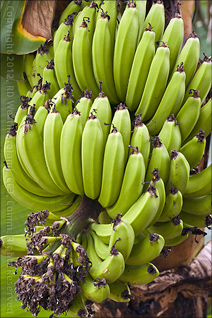 On maturity, the banana plant dies off so it is important to leave one baby in place, to take the spot of the parent.
On maturity, the banana plant dies off so it is important to leave one baby in place, to take the spot of the parent.
Banana plants like lots of open sun and all the water you can give ’em. A little fertilizer is not bad either. Several of the first babies I transplanted never got very big because of being in the shade. It’s also worth mentioning that a lot of baby plants can stifle the development of the parent plant. Cutting them out and relocating them is good for both. When cutting them out, it’s best to cut with a sharp shovel, but leave them where they are until the babies start to fill out on their own. This may take 3 to 6 weeks.
Mango, Grafted Hybrid
There are many, many varieties of Mango. A wild version peppers the countryside of Puerto Rico. 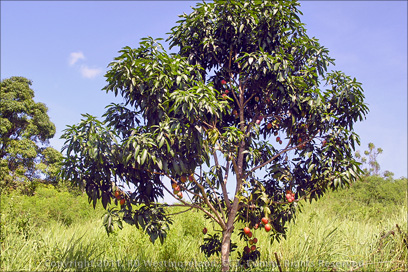 We have several on the property, but most folks don’t bother with collecting them. They are edible, but small with a large seed and often full of bugs. I’m surprised no one tries to make brandy from them.
We have several on the property, but most folks don’t bother with collecting them. They are edible, but small with a large seed and often full of bugs. I’m surprised no one tries to make brandy from them.
The hybrid we have produces huge fruit with a small flat seed. These are very sweet, slightly tart and very flavorful. It is now my most favorite fruit. These are to die for! If you freeze them and eat them as is, they taste like eating Mango Sherbet. Plus they are easy to cut into slices when frozen. Yum!!!!
Avocado, Grafted Hybrid
Avocados thrive here. The environment is perfect for them. Our hybrid is about 20 feet tall and produced about 60 fruit the year before. It normally produces every other year, 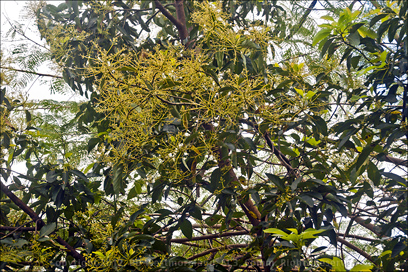 but last year it tossed about 12 fruit on it’s off year. Avocados are high on my favorites list… can’t get enough Guacamole! Unfortunately they mature almost simultaneously. What do you do with 50 mature Avocados? Hand some out to the neighbors or maybe Freeze some. Airtight zip-locks with lime juice seems to help with the oxidation issue.
but last year it tossed about 12 fruit on it’s off year. Avocados are high on my favorites list… can’t get enough Guacamole! Unfortunately they mature almost simultaneously. What do you do with 50 mature Avocados? Hand some out to the neighbors or maybe Freeze some. Airtight zip-locks with lime juice seems to help with the oxidation issue.
Some varieties mature at different times of the year spreading their window of availability. This is why I’m working on trying to plant a few more. I remember growing an avocado from seed, as a kid.
Mexican Lemons
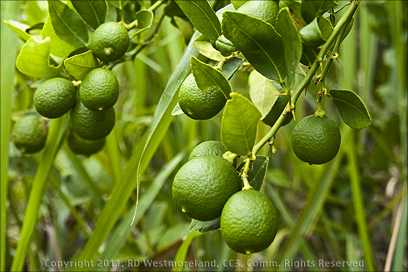 Locally referred to as PR Lemons. These are mild, thin skinned lemons I pick green and use like limes. The flavor is mild, but not sweet. They are great in Cuba Libres! My little tree is about 10 feet tall and produced about 400 fruit last year. I plan to freeze more of the juice this year. A hardy tree that thrives under harsh conditions. During the season, you can buy these small lemons in the produce isle and Goya bottles it for local distribution. Much milder than traditional yellow lemon juice. A good mixer.
Locally referred to as PR Lemons. These are mild, thin skinned lemons I pick green and use like limes. The flavor is mild, but not sweet. They are great in Cuba Libres! My little tree is about 10 feet tall and produced about 400 fruit last year. I plan to freeze more of the juice this year. A hardy tree that thrives under harsh conditions. During the season, you can buy these small lemons in the produce isle and Goya bottles it for local distribution. Much milder than traditional yellow lemon juice. A good mixer.
Coconut Palms
There are several varieties of coconut palm, but the two most common are the tall seashore type as featured on postcards and the shorter inland variety. We have the shorter version which makes collecting the coconuts much easier. Of the 8 or 9 coconut palms on the property, 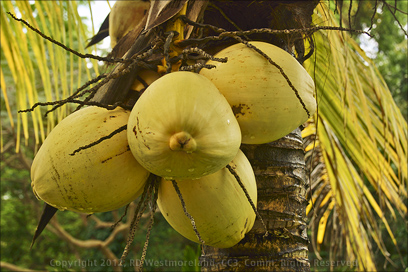 only one is producing. Good soil and sun are critical. They do not like being crowded by other trees. Palms are also good for erosion control as the roots can be quite extensive.
only one is producing. Good soil and sun are critical. They do not like being crowded by other trees. Palms are also good for erosion control as the roots can be quite extensive.
I have 7 palms started from the one producing coconut palm. I soaked them in water for 2 weeks, changing out the water every few days. About half of them sprouted. Those were put into their own oversized pots. They sat outside so long, they started to root in place, through their plastic pots. Fortunately I was able to relocate them to their new homes without a problem.
 Tropical Almond
Tropical Almond
There are several mature trees spread across the property and I’ve managed to relocate 3 baby trees from sprouting nuts. I have yet to try and collect them for harvest. These trees are deciduous so the leaves turn red in late February, then shed them all. By the end of March, they start producing new leaves again. They grow quite tall. Two of ours are over 40 foot. This is yet another tree you’ll see spread across Puerto Rico.
Caballeros Hot Peppers
These are deadly hot. On a par with Habañeros.
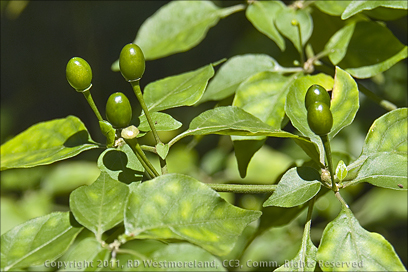 They are the smallest hot peppers I’ve ever seen at about 5/16″ long and 3/16″ across. They turn red/orange on maturity. The plant resembles a small bush and can get to about 8 feet tall. We have several. I think birds must help with seed distribution as new ones seem to radiate out from a mature plant by several feet. A few of these peppers give a nice kick to the Guacamole. They bear peppers year round. I’ll never forget the first time I tried one. They can be picked green too!
They are the smallest hot peppers I’ve ever seen at about 5/16″ long and 3/16″ across. They turn red/orange on maturity. The plant resembles a small bush and can get to about 8 feet tall. We have several. I think birds must help with seed distribution as new ones seem to radiate out from a mature plant by several feet. A few of these peppers give a nice kick to the Guacamole. They bear peppers year round. I’ll never forget the first time I tried one. They can be picked green too!
Guanabana Trees
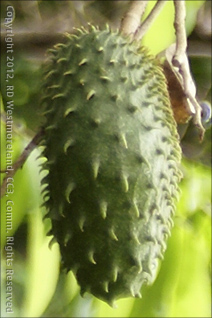 This bizarre looking fruit is used primarily for making juice. The soft white flesh contains a bunch of easy to remove black seeds. I’ve tried the juice… It’s very flavorful. Guanabana juice can be purchased in any store, including Walmart.
This bizarre looking fruit is used primarily for making juice. The soft white flesh contains a bunch of easy to remove black seeds. I’ve tried the juice… It’s very flavorful. Guanabana juice can be purchased in any store, including Walmart. 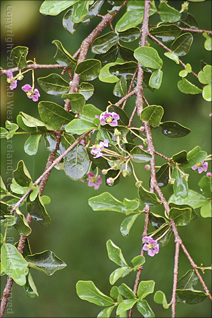 Delicious! Many health benefits are attributed to it. Our 2 trees produce fruit sporadically and I have yet to figure out when I should harvest them. Twice now, I’ve found over-ripe fruit, busted open on the ground. I saved the seeds!
Delicious! Many health benefits are attributed to it. Our 2 trees produce fruit sporadically and I have yet to figure out when I should harvest them. Twice now, I’ve found over-ripe fruit, busted open on the ground. I saved the seeds!
Caribbean Cherry (Acerola) Tree
The mature fruit resembles cherries, but contain 3 seeds in a tight cluster. They are quite tart until almost over-ripe. They are delicious eaten out of hand and are very high in vitamin C. Our tree is very tall, at about 14 feet. Most do not get this tall, but this one is at the outside edge of several palms and a huge Mango tree. So it’s fighting for light. I only give it water during the Dry Season. It is about 15 years old. The Acerola did not bear fruit for the first 10 years of its life.
Last, but not least-
Parcha
The vining Parcha (Passion Fruit) has flourished in the last year. So much so that we made a bunch of juice from it and froze it as concentrate. The fruit is similar to a gourd and has a smooth, stiff, semi-glossy outer shell. After cutting them in half, you can scoop out the gelatinous seeds. 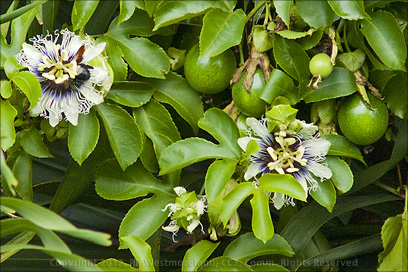 We lightly boil them with a little water to recover their aromatic flavor. Sugar is added per personal taste. They can also be eaten out of hand, but unless they are almost over-ripe, they are quite tart and only slightly sweet. The mature fruit will fall to the ground for easy picking. This is a semi-seasonal plant taking most of 2 years go through its life cycle. The main vine has mostly died back. I’m keeping tabs on it to see if it thrives after the end of the 2nd Dry Season. I have spotted them growing wild on the property.
We lightly boil them with a little water to recover their aromatic flavor. Sugar is added per personal taste. They can also be eaten out of hand, but unless they are almost over-ripe, they are quite tart and only slightly sweet. The mature fruit will fall to the ground for easy picking. This is a semi-seasonal plant taking most of 2 years go through its life cycle. The main vine has mostly died back. I’m keeping tabs on it to see if it thrives after the end of the 2nd Dry Season. I have spotted them growing wild on the property.
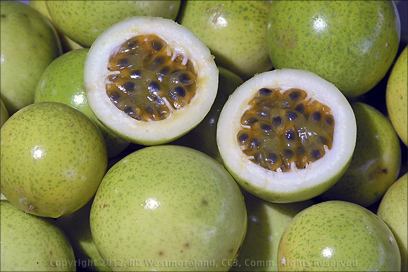 The large white blossoms with purple details are beautiful.. Hummingbirds love them.
The large white blossoms with purple details are beautiful.. Hummingbirds love them.
Our single vine dropped several hundred fruit over the course of 4 months. It eventually grew to cover about a 1/3 of a 35 foot tall Mango tree. I did start new Parcha from the seeds of this one and planted them along a 4 foot tall chain link fence. These are about a year old now. I have had to train then from trying to jump to the Palms. I suspect they will go to bloom during the summer.
Miscellaneous
We also have several coffee plants and a couple of orange trees, but they are not prospering due to a lack of attention. 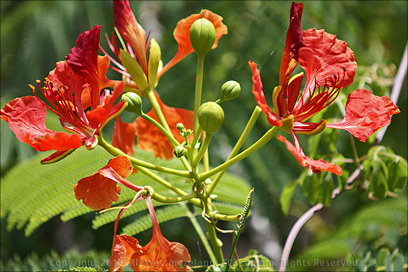 I’m working to improving their condition so we will see how that plays out.
I’m working to improving their condition so we will see how that plays out.
These are the plants and trees that normally thrive in Puerto Rico. Most are low maintenance.
Not content with what I have, I’ve proceeded to acquire more seeds via the Internet from Africa, Central Asia, and Central and South America. You can read about my effort to grow exotic plants from seeds, from this Post.
NOTE: As new plants and trees get planted, I’ll be posting more.
The Isle of Bamboo
 We are proud to announce our newest site- Isle of Bamboo.
We are proud to announce our newest site- Isle of Bamboo.
It is dedicated to the
myriad of ways bamboo enriches our lives and
our planet.
Pages cover Bamboo Fundamentals, Growing Bamboo for Beginners (like us) and a Page dedicated to Bamboo in Puerto Rico. More Pages are in the works.
The Site is optimized to run on Desktops and Laptops as well as tablets and mobile devices. ‘It’s easy on the eyes’.
If there ever was a ‘Super Plant’, bamboo is it.
Also, I will be glad to feature other gardens and nurseries of Puerto Rico as long as they fit with my content. Simply contact me and we can go from there.
Please understand, this is not an invitation for free advertising.
The Scurvy Dog o’ PR… ARRG!!!
